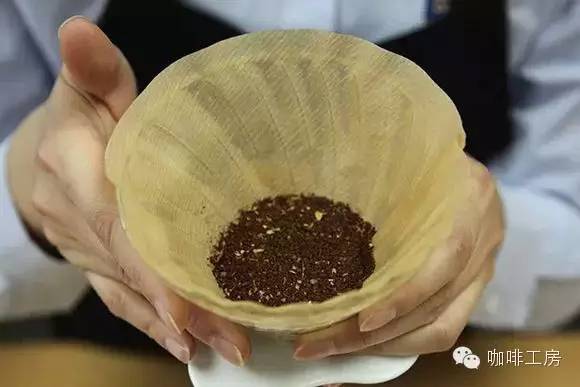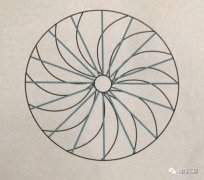Introduction to the design principle and design concept of v60 filter cup how many times is the most suitable for water injection of v60 filter cup?

Professional coffee knowledge exchange more coffee bean information please follow the coffee workshop (Wechat official account cafe_style)
Essential filter cups for hand-brewed coffee lovers: history, extraction and usage tips of Hario V60
The design of V60 is simple scouring, with spiral ribs to produce the function of twisting and extruding, increasing the amount of soluble matter.
The arc of the ribs is designed to increase the time for the water to stay in the particles.
1. The blue part is the rib that represents a straight line. Compared with black, the path of the water is much shorter, and if the ribs are bent properly, in addition to increasing the path of water, the isolated ribs will also concentrate the water to the center during the falling water level to produce the function of squeezing.
2, when the water level is falling, the water flow will concentrate the flow along the spiral ribs, and this action, just like the state when twisting towels, will squeeze the coffee particles in the water at once, and in order to maximize the extrusion function, in the control of water supply, the water level can not exceed the height of the powder layer.
3. When the position of water is too high, too much water will lead to the direction of the filter cup, which will not only greatly reduce the saturation of coffee particles, but also easily become thinner and watery in taste.
(tips: to judge whether the water level is too high, in addition to being able to observe from the surface, the extraction water column is also a focus of observation. If the water column is concentrated vertically, it means that the water supply is moderate. )
If there is a deviation of the extraction water column, it is that the amount of water is too large, and too much water will oppress the flow to stay where the resistance is low, resulting in a great decrease in the degree of extraction of coffee particles.
There are many factors affecting coffee extraction, among which, water temperature, grinding degree, ratio of powder to water, water used and extraction time caused by different water injection are artificially controlled. The extraction time will also change with different instruments.
How to extract?
The process that requires preparation:
Preferably pure water, heated to between 90 and 92 degrees Celsius (if there is no thermometer, do not wait for boiling, the center of the kettle bubbles at about this temperature, but if it is accidentally boiling, then set aside for 30-45 seconds)
Water temperature:
Light roasted coffee: 92 °- 95 °
Moderately roasted coffee: 90 °- 92 °
Medium and deep roasted coffee: 88 °- 92 °
Fold the filter paper along the seam
Put the filter paper into the filter cup and wash it thoroughly with hot water. if it is natural filter paper, you should be very careful. Wet cleaning can not only wash off the smell of the pulp, but also heat the filter cup. if it is not heated in advance, the temperature of the water will drop sharply during extraction, resulting in improper extraction.
Weigh 15g of coffee powder (the beans shown here are Colombians) and grind them moderately in a grinder. The particles are slightly thicker than salt. And pour the coffee powder into the middle of the filter paper, shake the filter cup horizontally, so that the coffee powder in the filter paper can be paved.
First water injection
A small water column is injected from the center, and then slowly wound out, just like gently laying a layer of water on the noodle, although it is a small water column, please be careful not to slow down the circle speed, because once the circle speed is too slow, the water column will flow in a single direction, so that the draught of the powder layer is uneven.
After the end of the first water supply, the coffee powder particles will push each other due to exhaust, resulting in expansion. When the expansion reaches the highest point or is about to rest (the surface water will slowly dry), it is the time to add water for the second time.
Second water injection
The second water injection also starts from the middle, with a small water column injected into the bottom of the powder layer. In order to concentrate the penetrating force of the water column, the range of movement around the water column should be small, about the size of an one-dollar coin, and then wound out. At the beginning of the second water supply, we should pay attention to the amount of water, and try not to exceed the height of the powder layer, that is, when the water column is wound close to the filter paper, the water supply can be stopped.
Hario V60 in the initial water supply, because most of the coffee powder particles are in a state of exuberant exhaust, and the air produced by it will soon be transmitted to the edge of the filter paper, so if you give too much water at this time, it will bring the water to both sides instead of the bottom, so use a small water column to speed up the circle to avoid these problems.
As the thicker powder layer on the edge of the original filter paper becomes heavier because of the draft, and as the water level falls and becomes thinner, the water level drops to half and the third water injection can be carried out.
The third water injection
From the third water supply, it is necessary to observe the extent of the decline of the water level, also from the center of the water supply circle, the amount of water should not exceed the height of the powder layer, then it will also be observed that the proportion of foam has already occupied the surface, and the third water injection will increase the tumbling of coffee granules, let all the deposited particles tumble, and then dissolve the soluble matter.
The rolling particles will start to rest because they stop adding water, and at this time they have to rely on the velocity caused by the falling water level to make the coffee particles produce friction, so once the addition of water stops, the coffee powder particles will sink, causing blockage, so pay special attention to the rhythm of adding water.
If the water is cut off too many times, it is tantamount to letting the coffee powder particles soak in the water all the time, which will lead to the astringent and miscellaneous taste of the coffee extract at the end.
When approaching the set amount (15 grams of powder, 225 grams of water), the filter cup can be removed.
Statement
Part of the source of articles and pictures
[handmade Coffee Collection]
Author: edited by the ugly duckling barista training center
Copyright belongs to the original author
.
Important Notice :
前街咖啡 FrontStreet Coffee has moved to new addredd:
FrontStreet Coffee Address: 315,Donghua East Road,GuangZhou
Tel:020 38364473
- Prev

Introduction to the use of hand-made coffee with the characteristics of v60 filter cup: what is the uniqueness of the design principle of v60 filter cup?
Professional coffee knowledge exchange more coffee bean information please follow the coffee workshop (Wechat official account cafe_style) hand-brewed coffee lovers must filter cup: the history and extract of HarioV60
- Next

V60 filter cup | the most detailed hario V60 handmade coffee brewing instructions on how many times the v60 filter cup is filled with water
Professional coffee knowledge exchange more coffee bean information please follow the coffee workshop (Wechat official account cafe_style) hand coffee lovers must filter cup: the history and extract of Hario V60
Related
- What is the Philharmonic pressure? How to use Philharmonic pressure to make delicious coffee
- Why does a hand grinder have more fine powder than an electric grinder?
- In addition to the hot mom, what is the difference between the versions of EK43 | ditting and Mahdi ek43?
- What kind of equipment do you need to make coffee by hand? Introduction to novice starter cooking equipment tools
- Espresso needs to be ground how thick and thin scale entry Italian Coffee Machine Bean Grinder investigation and Grinding course
- How much does it cost to open a small private cafe? How much does it cost to learn coffee? How to operate it?
- The difference between the flavor characteristics of hand-brewed coffee and coffee maker is hand-brewed coffee really better than coffee maker? Can I use a coffee machine to make coffee beans by hand?
- The difference between 01 and 02 of hario v60 filter cup what is the difference between 01 and 02 filter cup opening and cooking flavor
- What's the difference between the smart cup and the French kettle? Which is better, the French kettle or the Smart Cup?
- What's the difference between a smart cup and a V60 filter cup? The difference between the taste of smart cup and hand-brewed coffee

